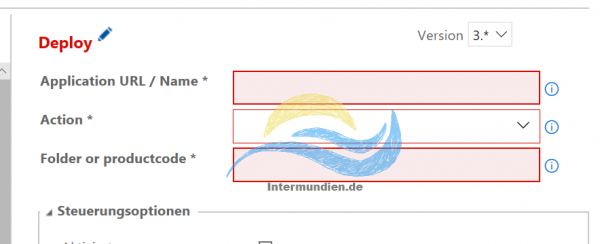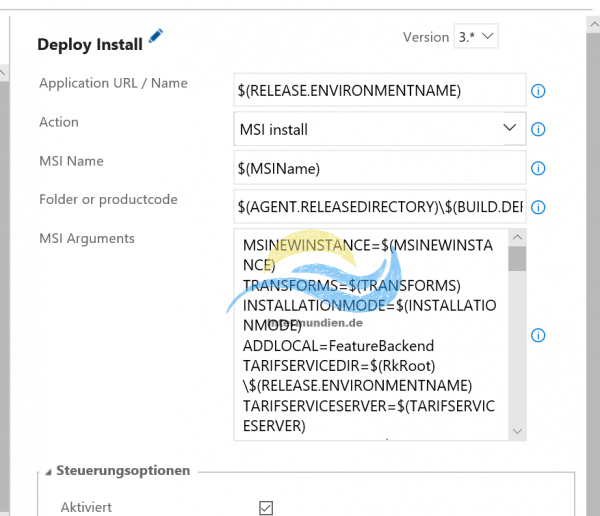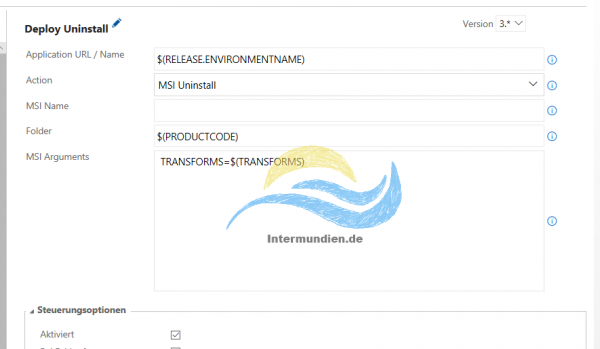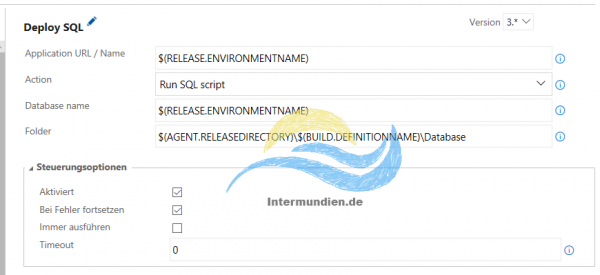
Team Service Erweiterung – Deploy
Mit dem Deploy Tool können Sie auf den Zielsystemen, auf dem die Build Agent installiert sind, MSI Anwendungen Deinstallieren und installieren. Zusätzlich enthält das Skript noch die Ausführung von SQL Skripte für die Aktualisierung der Datenbank. Hier besteht auch die Notwendigkeit, dass der Agent auf dem DB Server installiert ist.
Über den folgenden Link bekommen Sie das komplette Paket als ZIP bereitgestellt. Das Skript ist kostenfrei und kann nach Ihren wünschen angepasst werden. Download Deploy Team Service extensions
d7952ec20e351b038e60d0b5f03b0cfa
Damit eine Ausführung von Invoce-SQLCMD über den lokalen Agent erfolgen kann, ist die Sammlung VstsTaskSdk notwendig. Diese wurde bereits in meinen Paket hinzugefügt. Weitere Infos finden Sie hierzu unter vsts-task-lib.
- Als Vorraussetzung ist wie beschrieben, dass der Build Agent auf dem Zielsystem installiert ist. Eine Anleitung für die Konfiguration finden Sie hier: Deploy an agent on Windows
- Entpacken Sie das Zip und Importieren den PowerShell Task. Eine Beschreibung für den Import finden Sie hier: Eigene TFS Build / Release Aufgaben bereitstellen
- Erstellen Sie eine neue Release definition. Infos finden Sie hier: Define your CD release process
- Fügen Sie jetzt Ihre Aufgaben wie SPS Deploy hinzu.
- Geben Sie nun alle notwendigen Werte ein und führen die Bereitstellung aus.
Folgende Parameter können Sie mitgeben:
- Application URL / Name: Applikationsname für Protokollierung und SQL DB Name
- Action: Abhängig von der Tätigkeit haben Sie die Auswahl MSI Uninstall, MSI Install, SQL Run.
- Folder or productcode: MSI und SQL Ablageverzeichnis oder MSI Produktcode des Zielsystems
- MSI Name: Name des MSI Setups (setup.msi)
- MSI Arguments: MSI Parameter, Achten Sie darauf, dass Sie keine Hochkommas verwenden.
Beispiel:
ALLUSERS=$(ALLUSERS)
INSTALLLOCATION=$(WebIISRoot)\$(RELEASE.ENVIRONMENTNAME)
INSTALLDESKTOPSHORTCUT=0
DATABASESERVER=$(SQLServer)
DATABASSERVERPORT=$(RELEASE.ENVIRONMENTNAME)
DATABASENAME=$(RELEASE.ENVIRONMENTNAME)
DATABASEUSER=$(RELEASE.ENVIRONMENTNAME)
DATABASEPASSWORD=$(AppSQLUserPassword)
DATABSEENCRYPTION=$(SQLDBEncryption)
LOGDIR=$(WebLogDir)
Wichtig SQL Voraussetzungen:
Aktuell ist das Skript so konfiguriert, dass die Aktualisierungen der SQL Skripte folgende Vorraussetzungen benötigt:
- SQL Server horcht lokal auf localhost, Port 1433
- Wenn mehrere Skripte existieren, so müssen diese von der Benennung der Windows logik folgen. Das können Sie erreichen, wenn Sie z.B. A, B, C… die Dateien benennen. Die Prüfung können Sie im Datei-Explorer vornehmen.




$AppName = Get-VstsInput -Name "AppName" -Default "";
$Action = Get-VstsInput -Name "Action" -Default "";
$DBName = Get-VstsInput -Name "DBName" -Default "";
$MSIName = Get-VstsInput -Name "MSIName" -Default "";
$FolderProductcode = Get-VstsInput -Name "FolderProductcode" -Default "";
$MSIArguments = Get-VstsInput -Name "MSIArguments" -Default " ";
$Timeout = Get-VstsInput -Name "Timeout" -Default 300;
Write-Output "Action selected - $Action"
Write-Output "Application name - $AppName"
Write-Output "Database name - $DBName"
Write-Output "MSI name - $MSIName"
Write-Output "Folder or Productcode - $FolderProductcode"
Write-Output "MSI arguments - $MSIArguments"
Write-Output "Timeout in sec - $Timeout"
Write-Output "Start Deploy"
$DataStamp = get-date -Format yyyyMMddTHHmmss
$LogPath = $Env:SYSTEM_DEFAULTWORKINGDIRECTORY
$MSIArguments = $MSIArguments -replace "`t|`n|`r"," "
$timeouted = $null
if ($Action -eq "uninstall")
{
Write-Output "Uninstall App - ($AppName)......."
$uninstall = 0
# Check productcode and MSI exists
if ($FolderProductcode -like "{*}"){
Write-Output "Search guid: " + $FolderProductcode
$properties = "identifyingnumber","name","vendor","version"
Get-ChildItem HKLM:SOFTWARE\Microsoft\Windows\CurrentVersion\Installer\UserData\*\Products | ForEach-Object {
$root = $_.PsPath
$_.GetSubKeyNames() | ForEach-Object {
try {
$RegKeyPath = (Join-Path -Path (Join-Path -Path $root -ChildPath $_) -ChildPath InstallProperties)
$obj = Get-ItemProperty -Path $RegKeyPath -ErrorAction Stop
if ($obj.UninstallString) {
$guid = ($obj.UninstallString -replace "msiexec\.exe\s/[IX]{1}","")
if($guid -eq $FolderProductcode){
Write-Output "Uninstall guid: " + $guid
Write-Output "Uninstall version: " + $obj.DisplayVersion
Write-Output "Uninstall name: " + $obj.DisplayName
Write-Output "Uninstall vendor: " + $obj.Publisher
$obj = ''
$uninstall = 1
}
}
} catch {
}
}
}
}
else{
$FolderProductcode = "$FolderProductcode\$MSIName"
Write-Output "Check MSI path: " + $FolderProductcode
if ($FolderProductcode -like "*\*.msi") {
if (Test-Path $FolderProductcode) {
$uninstall = 1
}
}
}
# Uninstall
if($uninstall -eq 1){
$logFile = $LogPath+'\'+$AppName+'-'+$AppVersion+'-Uninstall-' + $DataStamp+'.log'
$arguments = '/q /x ' +$FolderProductcode+ ' /passive ' + $MSIArguments + ' /l*v ' + $logFile
$output = 'Start-Process "msiexec.exe" -ArgumentList "' + $arguments + '" -PassThru'
Write-Output "Run: " + $output
$Request = Start-Process "msiexec.exe" -ArgumentList "$arguments" -PassThru
$Request | Wait-Process -Timeout $Timeout
If ($($Request.ExitCode) -eq '0')
{
Write-Output "$AppName uninstalled successfully!"
}
else{
Write-Error "$AppName failed to uninstall with exit error: $($Request.ExitCode)"
}
Write-Output "Request: $Request"
}
else{
Write-Warning "MSI or productcode not found: $FolderProductcode"
}
}
if ($Action -eq "install")
{
Write-Output "Install App - ($AppName)......."
$FolderProductcode = "$FolderProductcode\$MSIName"
# Check MSI exists
Write-Output "Check MSI path: " + $FolderProductcode
if (Test-Path $FolderProductcode) {
$logFile = $LogPath + '\'+$AppName+'-'+$AppVersion+'-Install-' + $DataStamp+'.log'
$arguments = '/q /i ' + $FolderProductcode + ' ALLUSERS=ALLUSERS /passive ' + $MSIArguments + ' /l*v ' + $logFile
$output = 'Start-Process "msiexec.exe" -ArgumentList "' + $arguments + '" -PassThru'
Write-Output "Run: " + $output
$Request = Start-Process "msiexec.exe" -ArgumentList "$arguments" -PassThru
$Request | Wait-Process -Timeout $Timeout
If($($Request.ExitCode) -eq '0')
{
Write-Output "$AppName installed successfully!"
}
else{
Write-Error "$AppName failed to install with exit error: $($Request.ExitCode)"
}
}
else{
Write-Error "MSI not found: $FolderProductcode"
}
}
if ($Action -eq "sql")
{
Write-Output "Run SQL Script - ($AppName)......."
Write-Output "Provide modul sqlps in powershell"
import-module "sqlps" -DisableNameChecking
# Check MSI exists
if (Test-Path $FolderProductcode) {
# Check SQL File and run
Write-Output "SQL file search: $FolderProductcode\*.slq"
$files = Get-ChildItem "$FolderProductcode\*.sql" -Recurse | Select-Object Name, Fullname | Sort-Object Name
foreach ($file in $files){
try{
Write-Output "Script run: invoke-sqlcmd -ServerInstance 'localhost' -Database $DBName -InputFile $file.FullName -QueryTimeout $Timeout -ConnectionTimeout $Timeout -ErrorAction 'Stop'"
invoke-sqlcmd -ServerInstance 'localhost' -Database $DBName -InputFile $file.FullName -QueryTimeout $Timeout -ConnectionTimeout $Timeout -ErrorAction 'Stop'
}
catch{
Write-Error "Error in script: $file.FullName"
Write-Error $error -foregroundcolor red
}
}
}
else{
Write-Error "SQL path not found: $FolderProductcode"
}
}
Weitere Infos:
Das könnte dich auch interessieren

Eigene TFS Build / Release Aufgaben bereitstellen
31. Januar 2018
Team Service Erweiterung – Application Pool Start / Stop
1. März 2018
3 Kommentare
Pingback:
Pingback:
Pingback: